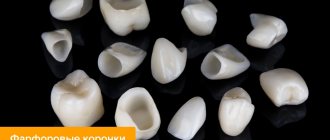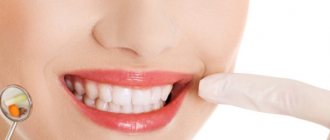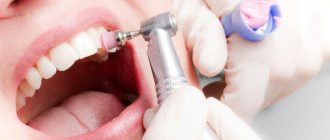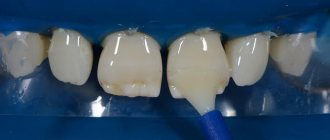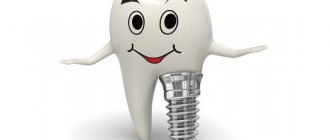2742
Preparation is a dental procedure that is based on grinding down a damaged tooth.
A manipulation is carried out to create additional space, which will then be used for the installation of an orthopedic structure.
Grinding is a mandatory procedure, without which it is impossible to properly fix the prosthetic structure.
The essence and purpose of the procedure
During turning, the surface layer of enamel is removed using special equipment equipped with high-speed burs with diamond tips.
Only with an ideally processed dental surface will the installation of the prosthesis be accurate and tight, which, in turn, will allow further avoidance of its rejection or the development of complications.
During preparation, the tooth is prepared for its further restoration. It takes on a cone-shaped shape (which simplifies the placement of the product), the remains of the carious cavity and old fillings are eliminated.
The procedure is considered by patients to be one of the most unpleasant in dentistry, so many of them do not decide to undergo prosthetics and end up losing their teeth.
But today, preparation technology has changed somewhat. The advent of new devices has made it possible to improve the technique, so there is virtually no pain or discomfort.
In addition, local anesthetics are used, which reduce the level of human sensitivity.
What types of ledges are used when preparing teeth for MC
-3. ledge symbol
+5. all listed
107. At what angle is the ledge formed under the MC structure?
+5. all listed
108. Where is the ledge formed when preparing teeth for MC dentures?
-2. at the level of the gingival margin
+3. all of the above
109. Select masses for obtaining two-layer prints:
110. Methods of gum retraction:
+4. all listed
- What metal alloys are used for the manufacture of MC prosthetic frames?
-3. Light cast (Ivoclar)
-4. Degudent (Degussa)
+6. all listed
112. Advantages of CCS over NCS in the manufacture of MK frames:
Indications
The procedure is required in almost all cases when restoration is carried out in the oral cavity, namely:
- To restore or replace worn-out filling material;
- When reconstructing a dental element after a fracture;
- To correct a congenital defect of the coronal part;
- When installing veneers, crowns, etc.;
- To carry out other restoration activities as one of its stages.
Preparation is also necessary if caries is discovered during the removal of the enamel layer.
In this case, to prevent the spread of pathogenic microorganisms to neighboring units, carious tissue and infected dentin are removed.
Rules for the use of glass ionomer cement for fixation of crowns and bridges, composition and properties of the material.
Come here if you are interested in reviews about ceramic inlays for teeth.
At this address https://www.vash-dentist.ru/protezirovanie/nesemnyie-p/koronki-np/nuzhno-znat-o-titanovyih.html together we will calculate the price of titanium crowns for teeth.
Techniques
Not long ago, a special drill was used to treat problem units. Today, grinding technology has improved significantly.
Several new techniques have been developed that have made the manipulation more comfortable, as painless and safe as possible:
Ultrasonic
Grinding occurs using ultrasonic waves , which are emitted by a high-precision device. The advantages of the procedure include:
- absence of negative feelings;
- minimal risk of damage to hard tissues;
- pulp safety;
- painlessness;
- no heating of dentin and enamel.
Laser
This technique is based on the process of heating water in dental tissues using a pulsed laser. Its effect allows you to easily remove the affected areas with an air-water flow.
The advantages are considered to be high precision of processing, silent operation of the device, absence of damage and heating of tissues.
Disadvantages - there is a minimal risk of infection, the technique can only be used for surface treatment.
Air abrasive
Here, instead of a drill, a mixture of abrasive substance and air is used , supplied under pressure. This force is enough to remove the required amount of enamel and dentin.
The advantages of the technique are:
- safety;
- speed of manipulation;
- minimal heating of tissues;
- processing accuracy;
- no vibration;
- preservation of the maximum volume of healthy tissue;
- painlessness.
But at the same time, air abrasive grinding cannot be used as an independent technique due to the fact that it can only act on surface layers.
Can be used in combination with other methods of preparing teeth for prosthetics.
Chemical
Preparation involves the use of chemically active substances (for example, acids), which, through their action, soften the desired area of enamel.
The positive aspects of the technique are painlessness, safety for healthy tissues, and the absence of heating.
The only drawback is the length of the process (on average, it takes about 30 minutes to process one unit).
Tunnel
This technique is the most common due to its ease of implementation and the ability to accurately control the thickness of the surface being removed.
It is carried out using a special diamond tip (or metal) with high rotational ability.
The only advantage of tunnel preparation is the high precision of processing.
The method has significantly more disadvantages:
- strong heating of the enamel;
- need for pain relief;
- high probability of tissue damage;
- there is a risk of infection.
It is impossible to single out the best method from the entire list. All of them are selected individually for each patient , based on the condition of the oral cavity, examination results, and in accordance with the specific type of defect.
Is it painful to grind teeth for crowns?
It is impossible to perform prosthetics without special preparation of teeth, which consists of grinding them down. It is used to level the surface of hard tissues. Many patients find this stage of prosthetics the most unpleasant due to the possible pain of the procedure. The following describes in detail the features of turning.
Necessity of the procedure
No person's teeth are perfectly shaped. The bulges present on them interfere with the production of comfortable crowns. Therefore, the dentist has to prepare or, as people say, grind the teeth.
The preparation stage is necessary to ensure that the manufactured dentures have the correct shape, fit well to the teeth and are firmly attached to them.
The tooth must be prepared by an experienced doctor, who will do this taking into account the thickness of the crown being installed. After all, the manufactured prosthesis should not interfere with talking and chewing food.
Grinding a tooth is often also a therapeutic procedure that removes tissue affected by caries. This stops the progression of the disease
Preparation methods
There are several methods used for preparing (grinding) teeth:
- Ultrasonic
- Using laser
- Chemical
- Tunnel
- Using an air abrasive device
An ultrasound machine performs grinding using waves that do not damage soft tissues or cause overheating of hard tooth tissues.
The amount of heat generated when exposed to ultrasound is minimal. The vibration of the device is low, so cracks do not occur during turning.
The procedure using this method is painless.
Preparation of tooth tissue for subsequent prosthetics using a laser does not cause discomfort or pain.
The advantages of the laser method include speed, noiselessness, safety and the absence of mechanical impact on the nerve endings, which irritates them
The ability of a laser to destroy pathogenic microflora makes additional treatment of the oral cavity with antiseptic solutions unnecessary.
The chemical preparation method takes longer. Special substances soften enamel and dentin. The use of anesthetics is not required, there is no heating of the tooth tissue, and there are no chips or cracks on its surface.
During air-abrasive grinding, sandblasting of hard tooth tissues is performed. Sodium bicarbonate and aluminum oxide serve as abrasives in this case. They are fed through the tip of a special apparatus onto the tooth and grind down the required amount of hard tissue without overheating it and maintaining its sufficient volume. The method is painless.
A turbine unit is used for tunnel turning. The speed of its operation is adjustable. Preparation is carried out with a diamond or metal tip
The classic method is the most painful and unsafe compared to the others.
Along with modern methods, the classic one is still used - grinding the tooth under a crown using a drill. This method is the most painful and unsafe compared to the others.
Unpleasant consequences can be a crack in the enamel or damaged gums.
But during such preparation, the doctor can control the volume of enamel removed, which is an advantage of this method.
It is necessary to choose a preparation method depending on the condition and structural features of the teeth of a particular patient.
He, for his part, before performing prosthetics, must familiarize himself with the technical equipment of the clinic and all the features of the procedure.
Features of teeth grinding
Before starting the preparation, the doctor usually takes an x-ray to clarify the characteristics of the pulp and its reaction to medications, the structure of the tooth, and also determine its condition.
If the nerves of the tooth are killed, then there is no need for anesthesia before preparation using the classical method.
Different types and materials of crowns require different grinding features.
For example, for metal-ceramics, the tooth is ground on all sides, for metal crowns - on the sides, so as not to injure adjacent units.
To install a zirconium crown, the tooth is ground to form a rounded shoulder. If the crown is made of porcelain, the tooth is given a cylindrical or conical shape.
If anesthesia before preparation was performed correctly, the patient does not experience pain during the procedure. It can only occur when a significant layer of dentin is removed or when soft tissue is compressed.
Types of ledges
A ledge is the part of hard tissue remaining after preparation on which the future prosthetic structure is planned to be secured. There are three varieties of it:
- Rounded . Used under metal-ceramic prosthesis. Allows you to preserve the maximum amount of hard tissue. Thickness varies from 0.8 to 1.3 mm.
- Knife-shaped. Designed for solid metal crowns. Ideal for turning inclined pieces. The width ranges from 0.3 to 0.5 mm.
- Brachial. It is the most reliable and durable when securing orthopedic products, but is uneconomical in terms of removing a large volume of tissue. The width is about 2 mm. Requires removal of the nerve from the tooth (depulpation).
If you do not create a ledge before prosthetics, the quality of the fit of the prosthesis will decrease significantly. This circumstance complicates oral care and increases the likelihood of developing recurrent caries.
Formation of the gingival ledge
Reliable mechanical stability and the quality of the marginal fit of an artificial crown largely depend on the topography and shape of the gingival border of the preparation. In this regard, the choice of method for preparing this zone is of great importance:
• non-recessive (tangential) preparation;
• shoulder preparation (Fig. 1-29).
The non-marginal preparation technique is used in the manufacture of stamped metal crowns, when the thin edge of the artificial crown is immersed in the periodontal sulcus to a minimum depth of 0.3 mm.
This method of preparation, used to prevent damage to the pulp, does not provide an exact preparation boundary, which makes it difficult to control the marginal fit of the artificial crown, and there is a high probability of errors (making a sharp and thin edge of the crown or over-extending it).
Rice. 1-29. The ratio of the thickness of the removed hard dental tissues during preparation with and without a shoulder
molting), therefore, in the manufacture of metal-ceramic crowns, this method of preparation is acceptable in the following clinical cases:
• when the narrowing of the tooth crown in the cervical region is significantly pronounced (lower incisors, upper lateral incisors, upper first premolars with bifurcated roots or teeth with significant exposure of the root);
• on inclined teeth;
• on those tooth surfaces where ceramic coating will not be used.
Currently, non-recessed (tangential) preparation has lost its relevance due to increasingly increasing standards of aesthetics and requirements for the hygienic properties of dentures. In all cases where this is technically feasible, teeth are prepared to form a ledge.
The tactics for choosing the type of ledge (its topography, shape, width) are determined by the age of the patient, the position of the supporting teeth in the dentition, the topography of the tooth cavity, and the design features of the artificial crown (Fig. 1-30). Preparation of teeth with the formation of a ledge, of course, significantly complicates preparation technique, and in some cases increases the risk of pulp damage. But at the same time, creating a ledge improves the aesthetic qualities of the prosthesis: the layer of the facing material of the artificial crown in the gingival zone becomes thicker and the metal frame does not show through. In addition, the creation of a ledge provides additional length of the prepared tooth surface for greater stability of the artificial crown, and the edge of the crown, being on the ledge, does not injure the soft tissues of the marginal periodontium.
Features of the topography of the ledge relative to the gingival margin are determined by the location of the teeth in the dentition, the condition of the periodontal tissues, aesthetic and hygienic requirements.
Depending on the location of the ledge, preparations are distinguished:
• supragingival (above the gum);
• paragingival (at the level of the gingival margin);
• subgingival (under the gum).
According to modern views on this problem, in all cases where this is possible, it is recommended to form a ledge above the gum using supragingival preparation.
Rice. 1-30. Types of ledges: a - a ledge of the same width along the perimeter of the tooth neck; b - a ledge formed only on the vestibular and oral surfaces of the tooth crown; c - ledge narrowed from the contact surfaces
In cases of teeth with weakened periodontium, a circular ledge is formed at the level of the gum (paragingival preparation).
Subgingival (subgingival) preparation technique can be used to achieve a high aesthetic effect only in certain cases:
• in patients with intact periodontium, the edge of the metal-ceramic crown can reach the middle of the periodontal sulcus, the depth of which is determined using a graduated probe;
• when preparing pulpless teeth and teeth restored with cast stump pins. • in patients with intact periodontium, the edge of the metal-ceramic crown can reach the middle of the periodontal sulcus, the depth of which is determined using a graduated probe;
Sometimes a combined preparation is performed: subgingival on the vestibular side, supragingival on the oral side.
When forming a ledge, a preparation angle is formed, formed by the planes of the surface of the ledge and the surfaces of the tooth stump (Fig. 1-31, a-b).
In the manufacture of metal-ceramic (metal-plastic) crowns, the best option is a gingival circular ledge with an angle
Rice. 1-31. Various forms of cervical ledges in the manufacture of artificial crowns: a - at an angle of 135°; b - at an angle of 90°
preparation 135°. This form of ledge provides a high aesthetic effect and reduces the risk of the negative impact of the crown edge on the marginal periodontal tissue.
The width of the ledge depends on the group affiliation of the tooth, the topography of the tooth cavity and varies from 0.3 to 1.2 mm.
The specific preparation technique depends on the anatomical structure of the tooth being prepared and its position in the dentition. Different preparation techniques for metal-ceramic crowns require a different sequence of preparation steps, but in all cases, in order to avoid excessive removal of hard tissue, grinding is carried out in strictly measured doses. Manipulations are performed with correctly selected, well-centered diamond abrasive instruments, with good lighting of the surgical field, with a drill at high speed, with full air-water cooling.
1st stage. Grinding of hard tissues from proximal surfaces (separation) is carried out on a turbine machine using a thin cylindrical diamond head, the diameter of which is less than the width of the ledge. To protect the adjacent tooth, a metal separating strip is inserted between it and the tooth being prepared. At this stage, in addition to separating two adjacent teeth, a preliminary ledge is created at an angle of 90° with a width of 0.5-0.7 mm, which is not brought to the level of the gum by 0.3 mm.
2nd stage. Preparation of the cutting edge (shortening of teeth). The incisors are shortened by 1.5-2.0 mm (1/4 of the crown height), the cutting edge of the teeth with an orthognathic bite is beveled in the oral direction at an angle of approximately 45° to the longitudinal axis of the tooth.
To process the chewing surface of the lateral teeth, special barrel-shaped or wheel-shaped diamond heads are used. The separation of the prepared molar or premolar from the antagonist teeth should allow the placement of a layer of metal and ceramic coating on the occlusal surface. Based on this, the amount of free space in these areas should be at least 1.5-2.0 mm. At the same time, the relief of the chewing surface is preserved, which is achieved by successively shortening the tubercles and deepening the fissures. Once the required separation is achieved, all sharp edges of the stump formed as a result of preparation are carefully rounded with diamond heads.
3rd stage. Preparation of the vestibular and oral surfaces of the tooth crown is carried out using shaped or diamond heads of various sizes and shapes. When performing this stage of preparation, the direction of the abrasive tool should be parallel to the axis of the tooth.
The manipulation is carried out as follows: using a diamond head shaped like a reverse cone, a groove is formed along the gingival edge, not reaching the gum 0.3-0.5 mm (Fig. 1-32).
The depth of the groove for the central incisors of the upper jaw and canines of both jaws is 1.0 mm, for the lateral incisors of the upper jaw - 0.7 mm, for the incisors of the lower jaw - 0.3-0.5 mm. Then, a cylindrical diamond head is used to grind hard tissues on the vestibular and oral surfaces of the tooth from the formed groove to the cutting edge or chewing surface.
Rice. 1-32. The vestibular surface of the anterior teeth is prepared in three planes: cervical - vertical, middle zone - with an inclination of up to 30° to the apexes and the occlusal third - with an inclination of 45°. The oral surface in the cervical area is prepared parallel to the vestibular cervical area.
In the area of the cutting edge (or chewing surface) and the adjacent third of the tooth crown, a bevel is formed from the vestibular surface, giving the tooth stump an oral direction. This provides conditions for thickening the facing layer of ceramics in this area.
Excision of tooth tissue from the oral surface of the upper anterior teeth is carried out sparingly, in the most gentle manner possible, while preserving the anatomical shape of the neck and palatal tubercle, which is necessary for fixing the future structure.
4th stage. Final preparation with the formation of an appropriate ledge at a given level. The ledge formed at the site of the gingival groove after preparation of the vestibular surface is connected with the ledges on the contact surfaces using a diamond head. The ledge is given the required shape using torpedo-shaped, flame-shaped and other diamond heads. After preparing the ledge at the level of the gum, if dictated by clinical conditions, it is immersed under the gum. The formation of the ledge at the final stages is carried out at low speeds of the drill.
5th stage. Formation of a gingival ledge and final treatment of the tooth stump.
The margin of the shoulder preparation should correspond to the contours of the gums, in the proximal areas rising towards the cutting edge (Fig. 1-33).
When removing irregularities in the area of the buccal-proximal angles of the gingival ledge, care must be taken to avoid immersion of the ledge to the level of the preparation border on the vestibular surface of the tooth. Otherwise, you can seriously injure the interdental papilla and disrupt the attachment of the gums in this area.
During the preparation of the ledge, the gum tissue must be completely protected from damage. If there is mechanical damage to the gum tissue, problems may arise when taking an impression. In addition, trauma can cause recession (displacement) of the gums after healing, which exposes the edges of the artificial crown.
Rice. 1-33. The margin of the shoulder preparation should correspond to the contours of the gums
To protect the gums at this stage, a retraction cord is used, which is placed in the gingival sulcus to displace the gums from the surface of the tooth during the formation of the ledge.
At the final stage of preparation of hard dental tissues, it is necessary to use finishing instruments, and the finishing operation itself should become a mandatory element of the preparation technique as a condition for achieving optimal marginal fit.
At the stage of finishing the tooth stump, thin diamond heads, carbide burs or sandpaper discs are used to smooth out sharp corners and uneven walls on the prepared surfaces.
The corners of the cutting edge and the corners of the contact surfaces are rounded with the same tools (Fig. 1-34).
Upon completion of grinding of the tooth tissues, the quality of the preparation is checked: the absence of irregularities, depressions on the vertical surfaces of the tooth crowns and in the ledge area. It has been established that the surface condition
Rice. 1-34. View of a tooth stump prepared for the manufacture of a metal-ceramic crown
Rice. 1-35. Control of the depth of excision of hard tissues of the anterior group of teeth using a silicone template
Upon completion of the work, the depth of excision of hard tooth tissues is controlled using a silicone template obtained before tooth preparation (Fig. 1-35).
Criteria by which it is determined whether a tooth is correctly prepared for a metal-ceramic crown:
• the tooth stump should be a reduced reproduction of the tooth crown, preserving its inherent anatomical shape before preparation;
• conical shape of the stump with a convergence angle of contact surfaces of 5-10° for anterior teeth, 8-10° for lateral teeth (the greater the height of the crown, the greater the convergence angle can be);
• the presence of a ledge 0.5-1.5 mm wide around the entire circumference of the tooth at the level, above or below the gum;
• the separation of the prepared tooth from antagonists in various occlusions should be at least 1.5-2.0 mm to ensure the possibility of manufacturing a structure of satisfactory strength;
• the height of the tooth stump must ensure satisfactory fixation of the artificial crown.
A temporary crown is made and fixed onto the prepared tooth.
2nd clinical stage
Taking into account the modern practice of metal-ceramic prosthetics (the traumatic nature of gingival and subgingival preparation), in order to prevent complications in the long term and increase the precision of crowns, it is advisable to take impressions at the 2nd clinical stage, 3-5 days after preparation.
Tactics
The entire grinding process can be divided into two stages:
- Elementary. The dentist determines the amount of tissue to be removed (for this he makes grooves - special notches).
Be sure to clean the tooth of damaged enamel and dentin, and remove “extra” tissue from the lateral convex surfaces. Such actions allow you to create the optimal size of the unit and give it the desired shape. - Final. Includes removal of carious areas (if any) and “old” fillings, pulp protection, as well as final treatment of the tooth cavity and walls.
At the end of all manipulations, the doctor evaluates the quality of the turning and the degree of sealing before applying the composite.
What modern dentistry offers for increased wear of hard dental tissues, and how effective the treatment is.
In this publication, we will discuss how to prevent metal allergies from occurring in dentistry.
Here https://www.vash-dentist.ru/protezirovanie/nesemnyie-p/ottisknyih-materialov-ortopedicheskoy-stomatologii.html we suggest you familiarize yourself with the classification of impression materials in dentistry.
Preparation for a metal-ceramic crown
Preparation for a metal-ceramic crown is perhaps the most important stage in creating the finished structure.
No matter how master of his craft the technician is; the extent to which the dental laboratory lacked modern materials and technologies; everything will be in vain if the doctor forms the stump not according to the standard. When preparing for metal-ceramics, quite a lot needs to be removed (especially compared to a stamped crown): 0.4-0.6 mm for the metal layer and 0.8-1.3 for the veneer. The opinions of the authors vary more or less within the indicated ranges. Some doctors believe that a tooth with living pulp must be depulped, since inflammation will occur sooner or later. Others adhere to the rule of preserving living tissue.
In order to avoid injury or burn to the pulp, it is necessary to retreat 1 mm from the nervous tissue (therefore, knowledge of anatomy and wall thickness is important). It is imperative to work with a water-cooled handpiece, carefully, interrupting as you work. First, the stages of preparing a tooth for a metal-ceramic crown will be listed briefly, and below a detailed description of each of them will be given.
Some nuances
Each orthopedic product has its own rules and requirements for its installation. Depending on the type of prosthesis, the preparation stages differ.
Under the crown
When it is planned to install a solid cast structure, grinding begins from the side surfaces to avoid damage to adjacent units.
For metal-ceramic crowns, about 2 mm of enamel is removed from the sides of the tooth, and a ledge is created that matches the type of product selected. To ensure a tight fit, the enamel is not polished, but is left slightly rough.
When a porcelain crown is installed, the tooth is ground down to a cylinder or cone shape, however, the ledge must be 0.1 cm into the gum.
If the prosthesis is made of zirconium, the ledge is formed with clear boundaries of a round or shoulder-shaped shape.
In the video, watch the process of preparation with a ledge for installing a crown.
Under veneer
Since a veneer is an overlay on the outer side of a tooth, when turning, special attention is given to the front surface
.
The sides are processed in two ways:
- leaving contact between teeth;
- with output to the inner side of the ledge boundaries.
Another point is that if the veneer is made of ceramic, the preparation is carried out to the gum. If a composite is used, no preparation is carried out (the layer is left slightly rough to improve adhesion to the material).
For tab
An inlay is a partial prosthesis, so when grinding it is important to make the side walls parallel and maintain the dimensions of the corners. Compliance with these conditions will ensure tight insertion and reliable fixation of the insert in the cavity.
Important! To eliminate the likelihood of developing repeated caries, the cavity of the tooth being restored is slightly expanded.
Under a prosthesis
In this case, preparation is carried out with the aim of shortening the prosthetic elements. During treatment, all thin and sharp walls, dentin and enamel protrusions are removed. The best option is to give the cavity an oval shape.
Under special circumstances, the pulp is first removed.
When splinting
Splinting is a procedure that secures units in a row and prevents their further loosening. The procedure involves minimal grinding of the enamel.
Typically, dentists adhere to the technique used when installing metal-ceramic crowns.
Some rules
Each orthopedic design has its own installation requirements. The stages of preparation also differ; let’s look at this in more detail.
Under the crown
In this case, the tooth surface is polished and about 2 mm of enamel and dentin are removed. This is a rather painful procedure that requires the use of anesthesia .
When using metal-ceramic crowns, preliminary removal of the dental nerve is required. If a patient has a porcelain crown installed, the shape of the ground tooth should be in the shape of a cone or cylinder.
Depending on the type of crown being installed, the doctor selects the necessary preparation method.
The video shows the stages of crown and bridge preparation.
Under veneer
In this case, it all depends on what material the veneers will be used from. In the case of ceramics, preparation is carried out to the gum.
If the composite is applied directly to the tooth, then the outer surface is not prepared at all . In this case, the enamel is slightly roughened to improve adhesion to the veneer.
For tab
The main feature of this type of turning is making the side walls parallel, this ensures the best insertion of the product.
To reduce the risk of developing secondary caries, the dental cavity is slightly expanded.
When preparing a complex cavity, retainers must be installed to prevent movement of the dentition. The area for the inlay should be deep into the dentin.
Under a prosthesis
In this case, preparation is carried out to level the occlusal surface of the teeth by shortening them. This procedure in some cases requires preliminary removal of the pulp.
During cleaning, the doctor removes all sharp and thin walls of the tooth, protrusions of enamel and dentin. It is considered optimal to give the cavity walls an oval shape. .
For elderly patients, preparation becomes more complicated due to the fact that their pulp takes on a thread-like shape, and the amount of dentin increases several times.
When splinting
In this case, the preparation method is selected based on the selected type of structure for splinting.
Most often, doctors adhere to the technique used in the case of installing metal-ceramic crowns.
Answers to frequently asked questions
Since the term “dissection” is not widely used among patients, many of them are keenly interested in information regarding this procedure itself.
- What layer of fabric is removed? The amount of grinding depends on the type of structure being installed, the characteristics of the tooth surface and its original volume.
Usually no more than 2 mm of hard tissue is removed. But this volume depends on the type of prosthesis being installed. So, before placing the inlays, only 0.5 mm is ground on each side. - How much does it hurt ? Modern technologies allow the procedure to be performed absolutely painlessly. When processing “live” units, local anesthesia is administered.
- How long does the process take? The duration of the process depends on the technique chosen by the doctor. On average, processing takes from half an hour to 2 hours.
- Is it possible to do prosthetics without preparation? Unfortunately, it is impossible to fix the product in a high-quality manner without grinding. If this manipulation is skipped, a person may face a number of negative consequences in the future.
- Can this be done for children ? This procedure has no restrictions regarding the patient's age. Children usually undergo chemical preparation.
- Why do my teeth and gums hurt, and what can be done ?
The cause of pain may be too deep grinding, as a result of which the dentist left a very thin tissue layer, and the nerves in the pulp react quite painfully when eating hot/cold foods. Another common cause of pain after turning is inflammation. In any case, the manifestation of this symptom is a reason to immediately seek medical help.
Does it hurt to put crowns on your teeth?
Almost all patients faced with the need to install a crown are interested in the question of whether the process of prosthetics involves pain and other discomfort. Unfortunately, almost all dental procedures are quite painful, so most of them are performed under local anesthesia.
Whether it hurts to put a crown on a tooth depends on the professionalism of the dentist himself and the characteristics of the body (sensitivity threshold) of the patient himself. As a rule, unpleasant sensations can arise exclusively during the preparatory stage of prosthetics, which includes:
- removal of the dental nerve;
- depulpation, cleaning of canals;
- grinding of hard tissues (the “working” tooth is ground down using a bur machine so that the crown “fits” well).
Nevertheless, the use of good anesthesia and precise, calibrated work by the dentist can reduce the risk of discomfort at the preparatory stage of prosthetics to nothing.
Therefore, those patients who are interested in whether it is painful to grind teeth for crowns can safely go to the dental office without fear of discomfort.
As for the process of installing a prosthesis on a dead tooth, it is absolutely painless - the product is adjusted and fixed with a special glue.
Advances in modern dentistry allow the use of local anesthetics, which eliminate the risk of discomfort during work.
The “working” unit is depulped (the nerve is removed), which means that pain sensations as such are completely eliminated.
Even the gums into which an anesthetic injection is given before starting work will not hurt - the dentist first applies an anesthetic gel to it. So, prosthetics, i.e.
Installation of metal-ceramic and ceramic crowns on the front or chewing teeth is a painless procedure.
The most potentially dangerous, from the point of view of the possibility of pain, is the preparatory stage - removing the nerve, cleaning the canals, depulping, turning the tooth. But the professional work of the dentist in combination with local anesthesia makes it possible to make it as comfortable as possible for the patient.
Reviews
Irina, 46 years old, Moscow: A year ago I had metal ceramics installed on 2 chewing teeth. The procedure, to be honest, is not pleasant - the doctor was unable to “seat” the crowns onto the stumps for a long time, as a result of which the gums became inflamed (even now they swell and hurt from time to time).
In order to “finish” both prostheses, I had to spend a lot of time and money (I went to the dentist 5-6 times while the preparation, fitting, and fixation of the crowns was going on). However, now I have no discomfort, I can bite, chew, and smile.
The dentures have not changed the original color and structure.
Konstantin, 35 years old, dentist, Novosibirsk: Putting any crowns correctly is an art. This is a job that requires professionalism, precision, care and precision. Modern anesthetics make prosthetics painless, so patients who have indications for crowns need not worry about experiencing discomfort.
Elena, 60 years old, St. Petersburg: Before going to the dentist, I thought for a long time, read reviews on the Internet, chose a clinic and the type of dentures.
As it turned out, I was worried in vain - despite the fact that 6 metal-ceramic crowns cost me a lot, the preparation, fitting, and installation itself were painless - there were no unpleasant sensations or complications.
Possible complications
Complications arise only if the dentist performed the preparation poorly. In such a situation, the following most often develop:
- inflammation of the gum tissue (in case of infection);
- secondary caries (with incomplete cleaning of the cavity from carious tissues).
If you do not consult a doctor in a timely manner, complications will subsequently lead to premature loss of supporting elements.
To avoid the negative consequences of grinding, you should contact only a highly qualified dentist.
To do this, having read the reviews and ratings in advance, you need to contact a center that provides quality services to its patients in accordance with all norms and rules, and strictly adhere to all medical recommendations and prescriptions.
Reviews
Modern methods of tooth preparation have made it possible to carry out prosthetics almost painlessly, quickly and with better quality.
This is evidenced by numerous reviews from patients who have undergone the process of restoring teeth with prosthetic structures.
You can share your experience of restoring teeth with orthopedic structures, talk about the impressions and feelings you experienced before and after the procedure, by leaving a comment on this article.
If you find an error, please select a piece of text and press Ctrl+Enter.
Tags fixed prosthetics prosthetics
Did you like the article? stay tuned
Previous article
The importance of timely detection and elimination of hidden caries
Next article
What can lead to darkening of teeth and how to correct the situation
Features of tooth preparation techniques and main stages
The preparation procedure involves “drilling” or grinding, which is carried out during the treatment of caries or the installation of a filling.
It is one of the most basic when making prosthetics or fixing veneers. What are the features of tooth preparation, and what methods are used for this today?
The content of the article:
